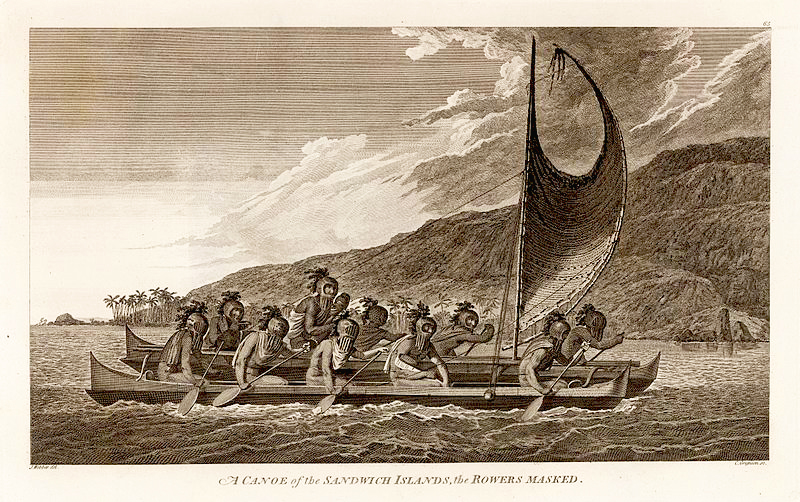The Geography of Immunology
A Chronological Overview of Hawai‘i and Public Health
by Charles Richter and John S. Emrich
July 2020, pages 34–35
This article originally appeared as an inset article in “How Honolulu’s Chinatown "Went Up in Smoke:" The First Plague Outbreak in Hawai’i, 1899–1900.”
 A Canoe of the Sandwich Islands Epidemic diseases have devastated the native population of Hawai‘i since 1778, when Captain James Cook first landed in the islands. Centuries of isolation meant that Hawaiians were particularly vulnerable to diseases from all over the world. Estimates of the native population in 1778 range from 300,000 to nearly 700,000. Just 40 years later, the figure had dropped to about 150,000, and by 1900, to only 28,800. Aggressive public health measures prevented an even worse decline, and today the Native Hawaiian population has returned to nearly 300,000.
A Canoe of the Sandwich Islands Epidemic diseases have devastated the native population of Hawai‘i since 1778, when Captain James Cook first landed in the islands. Centuries of isolation meant that Hawaiians were particularly vulnerable to diseases from all over the world. Estimates of the native population in 1778 range from 300,000 to nearly 700,000. Just 40 years later, the figure had dropped to about 150,000, and by 1900, to only 28,800. Aggressive public health measures prevented an even worse decline, and today the Native Hawaiian population has returned to nearly 300,000.
Since first contact with Europeans, the islands became a strategic trading and military location in the middle of the Pacific Ocean. By the late 19th century, as U.S. naval power increased, Hawai‘i became more attractive to the expansionist nation. American business and government interests incrementally seized control of Hawai‘i, which impacted every level of governmental control, including public health.
Polynesians first inhabit Hawaiian Islands
British explorer Captain James Cook lands in Hawai‘i; he publishes an account of the “Sandwich Islands,” providing the earliest documentation of European contact with the islands
The first trading ship lands in Hawai‘i on its way to China; sandalwood trade and whaling soon become major industries
“Okuu” (probably cholera) epidemic kills nearly 15,000
Kamehameha formally establishes Kingdom of Hawai‘i and proclaims himself king after a 15-year struggle with the ali‘i (chiefs)
King Kamehameha II abolishes the kapu—the traditional religious and legal system that governed all aspects of Hawaiian life
The first Protestant missionaries arrive from the United States
The Aedes mosquito is first identified in Hawai‘i
The first commercially successful sugar plantation is opened by Ladd and Company
Leprosy is first diagnosed in Hawai‘i
Influenza, dysentery, measles, and whooping cough kill approximately 10,000
King Kamehameha III enacts the Mahele, a land division act that introduces legal provisions for private ownership of land, opening the way for rapid growth of sugar plantations
A smallpox epidemic kills approximately 10,000; smallpox vaccination is made mandatory
Queen’s Hospital, named for Queen Emma, is founded to provide medical care to the Hawaiian people
Leprosy patients are first sent to Kalawao, Moloka‘i
Scarlet fever kills “great numbers” of Hawaiians
King Kamehameha V dies without an heir, ending the House of Kamehameha
Riots during the subsequent succession crisis are suppressed by U.S. and British troops; Kalākaua becomes King of Hawai‘i
The Reciprocity Treaty signed between the United States and Kingdom of Hawai‘i provides for duty-free import of Hawaiian agricultural products into the United States and of U.S. agricultural products and manufactured goods into Hawai‘i; the growth and consolidation of sugarcane plantations and processing plants soon follows
The Reciprocity Convention extends the Reciprocity Treaty (1875) and provides the United States exclusive rights to Pearl Harbor
King Kalākaua is forced to sign a new constitution (the “Bayonet Constitution”) that strips the monarchy of power and severely restricts voting rights. The constitution was written by the Hawaiian League, a group of mostly Hawaiian-born American and British businessmen and lawyers who favor annexation by the United States
King Kalākaua dies and is succeeded by his sister, Queen Lili‘uokalani, who refuses to recognize the Bayonet Constitution and calls for a replacement
The U.S. Marines arrive in Hawai‘i at the request of the Hawaiian League, effectively blocking Queen Lili‘uokalani from continuing her rule; the Provisional Government of Hawai‘i is formed; although the U.S. Congress, in 1894, found no party guilty of a coup against the kingdom, a joint Apology Resolution of Congress nearly a century later (1993) accepted U.S. responsibility for overthrowing the sovereign kingdom
The Republic of Hawai‘i is established
Government-led food inspection begins; Chinese Hospital opens
The Spanish-American War begins (April 25); the U.S. Territory of Hawai‘i is created when the United States annexes the islands (July 7); Pearl Harbor emerges as a key naval base for the war
Influenza pandemic kills 2,338
Measles outbreak kills 205
The United States enters the Second World War after the attack on Pearl Harbor (December 7)
Democrats take control of the Territorial Legislature and push for statehood
Hawai‘i becomes the 50th state of the United States
This article originally appeared as an inset article in "How Honolulu’s Chinatown "Went Up in Smoke:" The First Plague Outbreak in Hawai’i, 1899–1900."